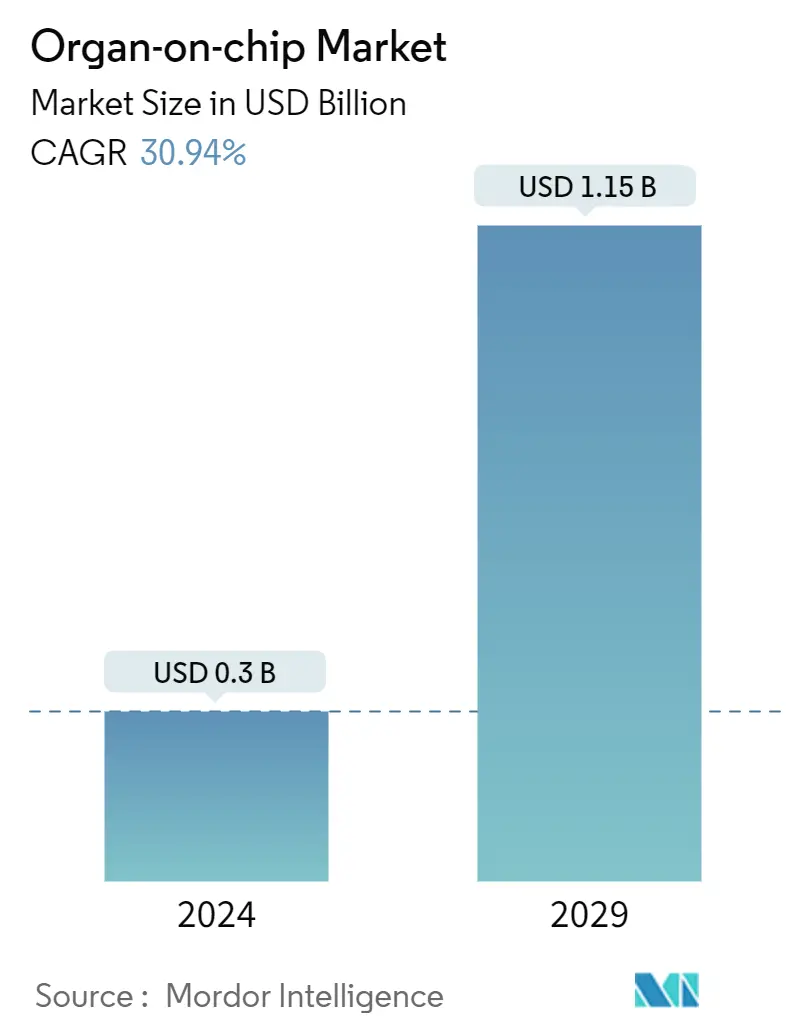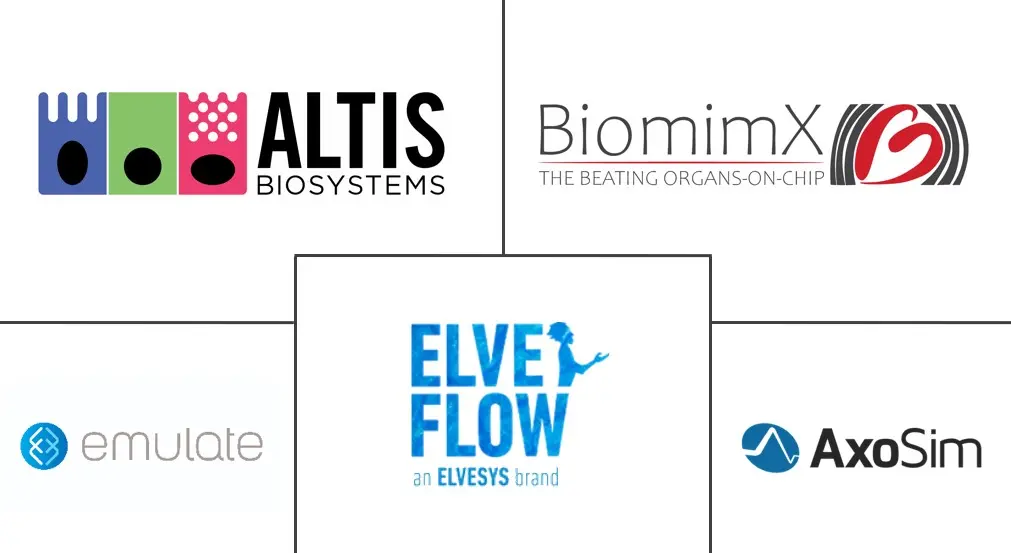Market Size of Organ-on-chip Industry

| Study Period | 2021 - 2029 |
| Market Size (2024) | USD 0.3 Billion |
| Market Size (2029) | USD 1.15 Billion |
| CAGR (2024 - 2029) | 30.94 % |
| Fastest Growing Market | Asia-Pacific |
| Largest Market | North America |
Major Players
*Disclaimer: Major Players sorted in no particular order |
Organ-on-Chips Market Analysis
The Organ-on-chip Market size is estimated at USD 0.3 billion in 2024, and is expected to reach USD 1.15 billion by 2029, growing at a CAGR of 30.94% during the forecast period (2024-2029).
The research community and the biopharmaceutical industry have mobilized with unprecedented speed against the COVID-19 pandemic. Hence, organ-on-chip was founded to be one of the most promising and go-to technology during the development of treatment and prevention options that were then under clinical studies for the SARS-CoV-2 infection. For instance, in March 2022, using a novel organ-on-a-chip platform, a research team from the University of Toronto's Faculty of Applied Science & Engineering identified a molecule (QHREDGS) with the potential to combat one of the most severe complications of COVID-19 infections. Thus the new ongoing research studies of organ-on-chip for the treatment of COVID-19 are expected to have a positive impact on the market over the coming years.
An organ-on-a-chip is a microfluidic cell culture device that contains continuously perfused chambers. This chip develops a narrow channel for the blood and airflow in organs, such as the lung, gut, liver, heart, and other organs. Such devices produce multiple levels of tissue and organ functionalities, which are not feasible using conventional 2D and 3D culture systems. It offers a wide range of applications, such as disease modeling, patient stratification, and phenotypic screening. The organ-on-chip market is driven by factors such as a requirement for alternatives for animal testing and the need for early detection of drug toxicity along with new product launches and advancements in technology that are also responsible for driving the market. For instance, in December 2021, Emulate, Inc., stated that its Brain Chip was sent to the ISS National Lab to study the effects of microgravity on human brain physiology as part of the tissue-chips in space initiative sponsored by the NCATS at NIH and the ISS-NL.
Furthermore, in September 2021, Fidia Farmaceutici S.p.A. and BiomimX Srl signed a research collaboration agreement aimed at introducing and applying new Organs-on-Chip-based technological solutions to the intra-articular medical device discovery process. Moreover, in November 2021, AIM Biotech launched the idenTx 40 Plate, a high-throughput organ-on-a-chip system that let researchers at biotechnology and pharmaceutical companies faithfully recreate the function of human organs and tissues without using animals for research. The demand for personalized medication and the vast applications of organ-on-chip beyond the pharmaceutical industry are the major factors creating growth opportunities for market players.
However, the complexity of organ-on-chip models may hinder market growth over the forecast period.
Organ-on-Chips Industry Segmentation
As per the scope of the report, an organ-on-chip is also called a multi-channel 3D microfluidic cell culture chip. It is a type of artificial organ that simulates activities, mechanics, and physiological responses of entire organs and organ systems. The size of the organ-on-chip is about an AA battery, and its transparency allows us to see the organ's functionality, behavior, and response at the cellular and molecular levels. The Organ-on-chip Market is segmented by Organ Type (Liver, Heart, Lung, and Other Organ Types), Application (Drug Discovery, Toxicology Research, and Other Applications), End User (Pharmaceutical and Biotechnology Companies, Academic and Research Institutes, and Other End Users), and Geography (North America, Europe, Asia-Pacific, and Rest of the World). The report offers the value (in USD million) for the above segments.
| By Organ Type | |
| Liver | |
| Heart | |
| Lung | |
| Other Organ Types |
| By Application | |
| Drug Discovery | |
| Toxicology Research | |
| Other Applications |
| By End User | |
| Pharmaceutical and Biotechnology Companies | |
| Academic and Research Institutes | |
| Other End Users |
| Geography | ||||||||
| ||||||||
| ||||||||
| ||||||||
| Rest of the World |
Organ-on-chip Market Size Summary
The organ-on-chip market is poised for significant growth, driven by its innovative applications in disease modeling, drug toxicity detection, and personalized medicine. This technology, which mimics the functions of human organs on microchips, offers advanced alternatives to traditional 2D and 3D culture systems, enhancing the accuracy of biomedical research. The market's expansion is fueled by the increasing demand for alternatives to animal testing and the need for early drug toxicity detection. The COVID-19 pandemic accelerated the adoption of organ-on-chip technology, as it proved instrumental in developing treatments and understanding the virus's impact on human health. Ongoing research and collaborations, such as those involving Emulate, Inc. and AIM Biotech, highlight the technology's potential across various applications, including space research and intra-articular medical device discovery.
North America is expected to lead the organ-on-chip market, with the United States at the forefront due to its robust investment in biotechnology and drug discovery research. The region benefits from a concentration of major players offering a wide range of services, including customized chip design and toxicological testing. Initiatives like Nikon Instruments' organ-on-a-chip imaging services and AIM Biotech's contract research services further bolster market growth. Despite the complexity of organ-on-chip models posing challenges, the market remains moderately consolidated with key players such as Altis Biosystems, AxoSim, and Emulate Inc. These companies are driving competition and innovation, ensuring the market's dynamic evolution over the forecast period.
Organ-on-chip Market Size - Table of Contents
-
1. MARKET DYNAMICS
-
1.1 Market Overview
-
1.2 Market Drivers
-
1.2.1 Requirement of Alternative for Animal Testing
-
1.2.2 Need for Early Detection of Drug Toxicity and New Products Launches
-
-
1.3 Market Restraints
-
1.3.1 Complexity of Organ-on-chip Models
-
-
1.4 Porter's Five Forces Analysis
-
1.4.1 Threat of New Entrants
-
1.4.2 Bargaining Power of Buyers/Consumers
-
1.4.3 Bargaining Power of Suppliers
-
1.4.4 Threat of Substitute Products
-
1.4.5 Intensity of Competitive Rivalry
-
-
-
2. MARKET SEGMENTATION (Market Size by Value - USD million)
-
2.1 By Organ Type
-
2.1.1 Liver
-
2.1.2 Heart
-
2.1.3 Lung
-
2.1.4 Other Organ Types
-
-
2.2 By Application
-
2.2.1 Drug Discovery
-
2.2.2 Toxicology Research
-
2.2.3 Other Applications
-
-
2.3 By End User
-
2.3.1 Pharmaceutical and Biotechnology Companies
-
2.3.2 Academic and Research Institutes
-
2.3.3 Other End Users
-
-
2.4 Geography
-
2.4.1 North America
-
2.4.1.1 United States
-
2.4.1.2 Canada
-
2.4.1.3 Mexico
-
-
2.4.2 Europe
-
2.4.2.1 Germany
-
2.4.2.2 United Kingdom
-
2.4.2.3 France
-
2.4.2.4 Italy
-
2.4.2.5 Spain
-
2.4.2.6 Rest of Europe
-
-
2.4.3 Asia-Pacific
-
2.4.3.1 China
-
2.4.3.2 Japan
-
2.4.3.3 India
-
2.4.3.4 Australia
-
2.4.3.5 South Korea
-
2.4.3.6 Rest of Asia-Pacific
-
-
2.4.4 Rest of the World
-
-
Organ-on-chip Market Size FAQs
How big is the Organ-on-chip Market?
The Organ-on-chip Market size is expected to reach USD 0.3 billion in 2024 and grow at a CAGR of 30.94% to reach USD 1.15 billion by 2029.
What is the current Organ-on-chip Market size?
In 2024, the Organ-on-chip Market size is expected to reach USD 0.3 billion.

